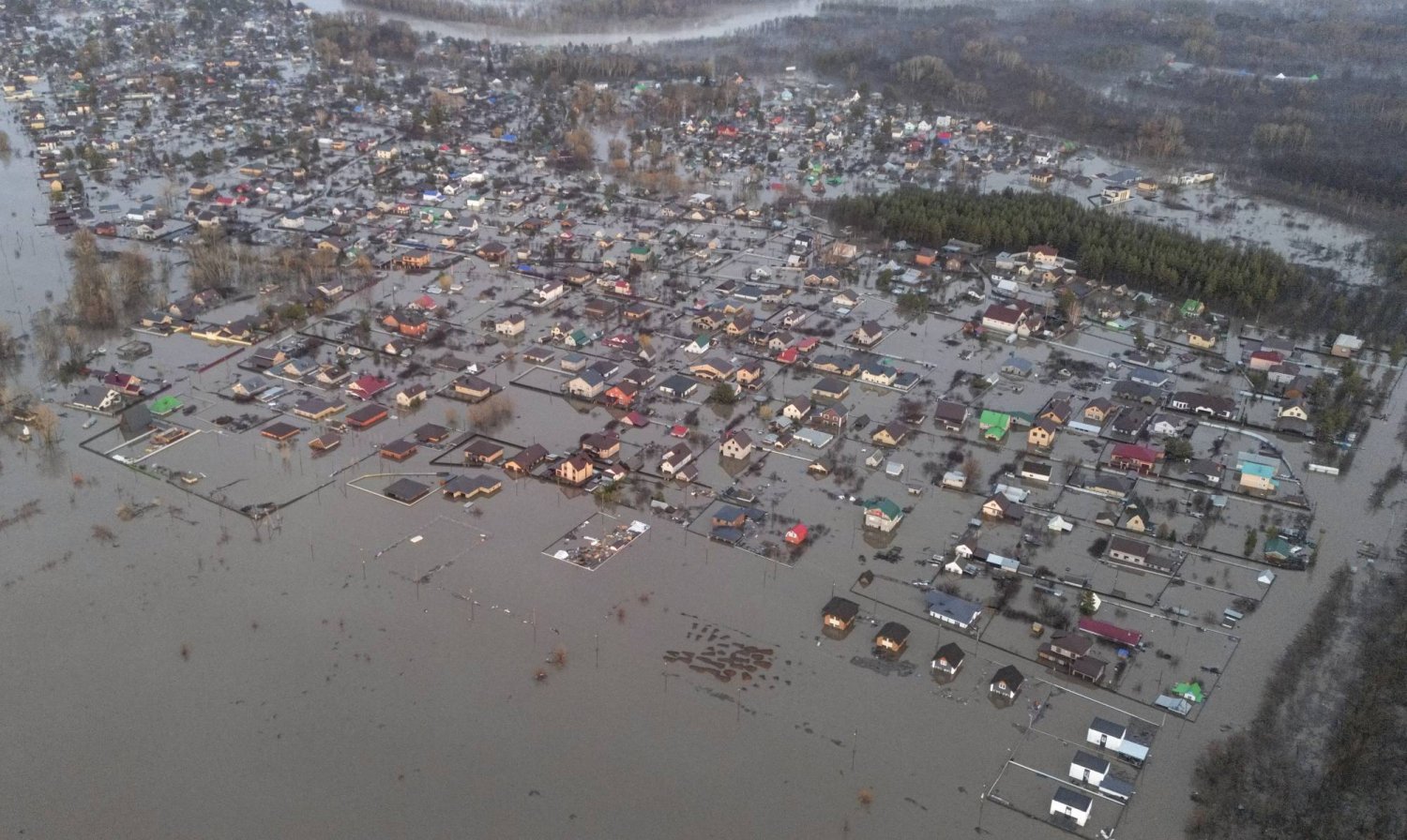ALMATY, Kazakhstan — Water and Kazakhstan: There’s either not enough of it — or entirely too much.
This year’s seasonal floods are an example of the second problem, necessitating more than 15,000 evacuations to date, killing livestock, cutting off access to highways, and sending dozens of villages under water after an abrupt period of warm weather led to a huge snowmelt.
At present, at least four people — all in the eastern region of Abai — are thought to have died, with the Emergencies Ministry warning of an ongoing flood risk in multiple provinces in the north, east, and center of the country.
Unsurprisingly, the havoc the floods have wrought has triggered sharp criticism of authorities who have once again proven themselves disaster-unprepared.
And the sight of so much of a scarce resource being put to bad use, instead of good, has put another crucial item on the agenda: How to conserve and redirect precious meltwater in light of the Kazakh summers that climate change is making longer, hotter, and drier?
Water World
Local states of emergency have been declared in 20 different locations hit by the flash floods to date.
In Abai’s Ayagoz district, video from March 26 showed two villagers marooned atop a tractor while sinking into the fast-flowing river.
Tursyngali Kazhigereyev, the father of one of the men, said the pair were stranded on the vehicle “for 10 hours, just 10 minutes from dry land,” but that when he called for emergency services, no help came. A man mounted a horse in a bid to save the pair but abandoned the effort after it became clear he could drown in the strong current.
Village head Madiyar Baizhumanov told RFE/RL’s Kazakh Service that he had “asked everywhere he could…even for a helicopter.”
But Ayagoz district didn’t even have boats available for rescue until they arrived from the city of Semey, he said.
The two men are among four people missing and presumed dead in Abai.
Over the weekend, flooding also ravaged Kokpekti, another district in Abai.
Residents of the villages of Bigash and Kokzhayik contacted RFE/RL’s Kazakh Service with video showing their houses partly submerged.
But Abai’s regional authorities published a post on Instagram noting that “flood control measures have been taken in the village of Bigash. There is no risk of the flooding of houses.”
“What kind of flood-control measures are taken after the flood?” read one angry comment on social media.
“Take a video of the entire village, don’t show only the places you want to show,” read another.
Comments to the video were eventually disabled.
In the northwestern province Aqtobe, all but one district was badly affected, while the floods even reached the airport of the province’s administrative center — a city of 500,000 people.
One widely shared clip on Telegram showed residents of the province ankle deep in water as a bus drove through the floodwaters.
In another, a man grinned as he retrieved a fish from the middle of a flooded road.
Near the Kazakh capital, Astana, in the town of Qoyandi, villagers wading down a street blamed local authorities for failing to clear the large piles of snow that had melted, flooding at least three homes.
Qoyandi Mayor Bakyhtkhan Soltanbai rejected the accusations in an interview with RFE/RL’s Kazakh Service, claiming that all snow-clearing work had been carried out on schedule, despite not being given enough money for the job.
Reprimands, Reprimands
Recriminations at the government level followed a familiar pattern, with President Qasym-Zhomart Toqaev railing at ministers and provincial administrations for their poor planning and ineffective coordination after apologizing to citizens for the floods.
Toqaev also criticized the government-approved action plan for developing and managing water resources until 2030 as too “declarative,” calling for officials to further develop the document.
“Forecasting work was completely absent, which is due to the shortage of relevant specialists,” he fumed on March 30 after returning from a visit to China, where he attended the Boao Forum for Asia.
“The consequences and scale of the disaster, even taking into account weather conditions, could have been less if the [provincial administrations] had carried out all planned flood-control measures annually. [They] apparently did not do this,” said Toqaev, who will visit a flooded region on April 4, his press office said.
The main problem for Toqaev is that whether it is forest fires in one region, floods in another, or earthquake scares in Kazakhstan’s largest city of Almaty, the government’s planning and response always seems to inspire anger rather than praise.
And he has done little to address the widely held notion that systemic corruption is weakening the country’s hand in fighting natural disasters.
“People are tired of this empty criticism. He always criticizes, but we never see a result,” said Sanzhar Bokaev, an opposition-oriented former candidate for parliament, in an April video on the floods liked more than 45,000 times on Instagram.
“It isn’t just the government that is guilty in these disasters, it is Toqaev himself,” he vented.
First Floods, Now Droughts?
Kazakhstan’s state meteorological agency Kazgidromet has politely disputed suggestions from the president and regional officials that warnings were not timely.
Danara Alimbaeva told journalists on April 2 that above-average snowfall in the winter and a sudden onset of warmer temperatures had created ideal flooding conditions.
“Starting in December, we warned that there would be flood-prone regions,” said Alimbaeva.
“More than 100 storm warnings were issued since March. They were sent to both local executive bodies and central authorities,” she insisted.
Deputy Emergencies Minister Bauyrzhan Syzdikov said the same day that his ministry had not been prepared for large volumes of water arriving from elevated steppe land — rather than rivers and other bodies of water — something he said had caused villages normally outside the flooding zone to suffer.
“No country can account for this type of water currently,” Syzdikov said.

What is less disputed in terms of bad planning is that existing water infrastructure is either inadequate or poorly maintained.
Despite being reinforced last year, the wall of a Soviet-era reservoir in Aqtobe burst during the floods, sending water into the Irgiz River.
Another complaint of experts is that while local authorities are supposed to clean clogged ditches that elevate the risk of flood in times of high discharge, this work is rarely done.
The bitter irony of the spring floods is that the water that has taken villages underwater will be sorely needed closer to the end of the growing season.
If major flooding has in recent times happened roughly every half-decade — authorities say the current floods are worse than those in 2012 and 2017 — then bad droughts have been every other year of late, hitting agriculture hard both last year and in 2021.
And Kazgidromet has warned that another drought might be on the cards this summer, with both higher-than-average temperatures and lower-than-average precipitation forecasted for the beginning of the season.
Water analysts consulted by RFE/RL’s Kazakh Service argued that Kazakhstan could offset both problems by investing more in control gates to regulate upstream flow and set aside water for downstream agriculture.
Such regulation is currently already in use in southern Kazakhstan, where its operation helps secure the water from the Syr Darya River necessary to irrigate rice fields in Qyzylorda Province.
Last week, the Water Resources and Irrigation Ministry said it was building something similar for the Esil River in the northern Akmola Province that surrounds Astana.
But in Aqtobe, dams and other water infrastructure are aging and poorly maintained, leading to blockages because “there is no money for it,” suggested one expert, Amirkhan Kenshimov.
Other experts argued that building new reservoirs — the government’s preferred water management strategy — might exacerbate rather than alleviate Kazakhstan’s summer droughts in the long-term.
“Kazakhstan’s freshwater reserves are 100 billion cubic meters. They say that if 20 reservoirs are built there will be another 2 billion cubic meters [available]. Why should we spend so much money for this?” asked Erlan Badashev.
Amid high temperatures and due to the large surface areas of reservoirs, “this water will simply evaporate,” he told RFE/RL’s Kazakh Service.
Source: RFERL










